The lupine plant (Lupinus) is a member of the legume family. This genus is represented by perennial and annual herbaceous plants, dwarf shrubs, shrubs and dwarf shrubs. From Latin the word "Lupus" is translated as "wolf", while in the people this plant is also called "wolf beans". Under natural conditions, it is found in 2 regions: in the Western Hemisphere, in the area from the Pacific to the Atlantic Ocean and from Alaska to Patagonia, about 200 species grow, and in the Mediterranean-African region, 11 annuals and 1 perennial grow. In culture, of the American species, only the variable lupine is grown, which the Incas have already begun to breed, and the many-leaved lupine. The culture is highly resistant to drought; therefore, some of its species can be found in the deserts of California, Peru, Arizona, Texas and Chile, and also in the Sahara. English breeder D. Russell in 1911 created new types of lupine, which are highly decorative, they were called "Russell's hybrids", since then they are very popular among gardeners who decorate both flower beds and garden plots with them.
Content
Brief description of cultivation
- Landing... Sowing seeds for seedlings is carried out in the first days of March, it is transplanted into open soil at the stage of formation of the second or third true leaf plate. In open ground, sowing of seeds is carried out in April or in late autumn before winter.
- Bloom... Lupine blooms in the last days of May or the first in June, the duration of flowering is about 20 days.
- Illumination... Needs bright sunlight.
- Priming... It can be anything. However, the culture grows best on loamy soil with a reaction from slightly acidic to slightly alkaline.
- Watering... In spring, watered abundantly, and then moderately.
- Fertilizer... Top dressing begins in the second year of growth in spring. To do this, a complex mineral fertilizer is introduced into the soil 1 time during the season, which does not contain nitrogen.
- Reproduction... Seeds.
- Harmful insects... Aphids, sprout fly larvae and root weevils.
- Diseases... Root and gray rot, fusarium wilting, phomopsis, rust, mottling and viral mosaic.
Features of lupine
Lupine has a rod system of roots, which in some cases can go 200 cm deep. On the surface of the roots there are small bulges that absorb nitrogen from the air, while saturating the soil under the bush with it. The stems can be herbaceous or woody, and the branches are bulging, creeping or erect. Long-petiolate alternate leaf blades have a finger-like complex shape; they are connected to the shoot by a leaf cushion with a long stipule. The apical racemose inflorescence consists of many flowers, which are arranged semi-whorled, whorled, or alternately. In some species, the length of the inflorescences can reach up to 100 centimeters, the flowers can have a different color, for example: white, pink, purple, yellow, red, cream, or all shades of purple. For different types of lupine, the seeds may differ in size, shape, or color. For example, the beans of the American species are smaller than those of the Mediterranean. After the beans are dry, they crack and seeds, which are very small grains, fly around them. The culture is used not only to decorate flower beds, but also as a green manure. The fact is that the foliage and shoots of lupine, rotted in the soil, become an excellent fertilizer. Fodder lupine is also widely cultivated.
Growing lupine from seeds
Sowing
Lupine is grown from seeds through seedlings. To do this, they are sown in the first days of March in a box filled with a loose substrate, which includes turf soil, peat and sand (2: 2: 1). Before starting sowing, the seed is combined with powdered root nodules of old lupins, this helps to accelerate the growth of nitrogen-absorbing bacteria. Seedlings should appear after 7-15 days. In order for the seedlings to be friendly, it is recommended to cover the crops from above with moistened gauze and put in a warm place.
Seedling care
If you decide to grow lupins from seeds, then you need to take into account that the grown seedlings may not retain the varietal characteristics of the parent plant. Typically, the crop is grown from seed by breeders. Pink and purple colors are dominant, therefore they are able to survive in the next generation. At the same time, it is highly likely that the white color will be lost when growing a plant from seeds.
Seedlings are planted in open ground after the formation of two or three true leaf plates in them. Pulling with planting is not recommended, because the tap root system develops very quickly, and it can be injured during transplantation.
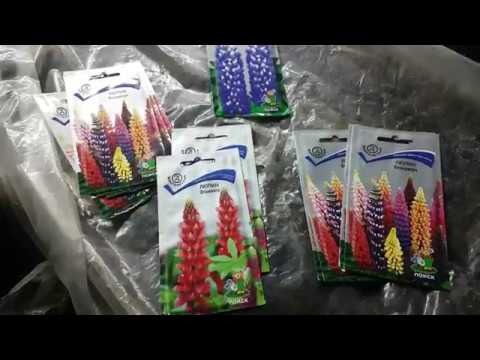

Watch this video on YouTube
Planting lupine in open ground
What time to plant
It is possible to grow lupine from seeds not only through seedlings. If desired, the seeds can be sown directly into the open ground, they do this in April after the snow cover disappears, but the planting site should be prepared in the autumn. Most often, gardeners resort to winter sowing of seeds of this plant, which is carried out in the last days of October. Sowing lupine before winter has many advantages, and it has practically no contraindications. Before the onset of winter, the seedlings do not have time to appear, while the seeds will be able to undergo natural stratification, and friendly shoots will appear in the spring.
Seed material is buried in the soil by only 20 mm, after which the surface of the site is covered with a layer of mulch (peat). In spring, friendly shoots will appear, with the first flowering beginning around August.
Landing rules
The culture grows best on sandy loam or loamy soil of slightly alkaline or slightly acidic reaction. The site should be chosen open and well lit.During the preparation of the site for spring sowing in the fall, the acidic soil must be limed; for this, lime or dolomite flour is added to it (5 kilograms per 1 square meter of the site).
It will be necessary to re-add flour to the soil after 3 or 4 years. Excessively alkaline soil is corrected with peat, for this, during digging, it is brought into the ground at the rate of 5 kilograms per 1 square meter. In springtime, grown and matured seedlings are planted in the area that you prepared in the fall, while the distance between the bushes should be from 0.3 to 0.5 m.


Watch this video on YouTube
Lupine care
It is very easy to grow lupines on your site. In the event that you cultivate perennial lupine, then during the first season it will be necessary to systematically loosen the soil surface on the site, while pulling out all the weeds. Adult bushes will need regular hilling, because their root collar is gradually exposed, while lateral rosettes become detached. When the bushes are 5 or 6 years old, they must be dug up and removed from the site, the fact is that over time the middle part of the plant dies off, which has an extremely negative effect on the decorativeness of the plant. Vigorous varieties will need support as their stems can be injured by strong gusts of wind. In the event that you need the bushes to bloom until the very frost, timely pruning of the inflorescences that have begun to fade should be carried out, do not allow them to dry out directly on the bush. If such inflorescences are removed in a timely manner, then perennials can bloom again. Watering lupines abundantly is necessary only in spring, and then watering should be moderate.
Top dressing
In the first year of growth, the bushes do not need feeding. Fertilizer begins to be applied to the soil only from the second year and is done in the spring. For this, a mineral complex fertilizer is used, which does not include nitrogen. 5 grams of calcium chloride and 20 grams of superphosphate are added to 1 square meter of the site. You need to feed the bushes annually in the spring.
Diseases and pests
During the formation of buds, aphids can settle on the bushes. At a later time, the nodule weevil or the larvae of the sprout fly can harm the lupine. In order to get rid of them, you will have to treat the bushes with an insecticidal solution.
The most dangerous of all diseases for culture are: fusarium wilting, mosaic, rust, rot (root and gray), spotting and phomopsis.
For the purpose of prevention, it is imperative to follow the rules of agricultural culture. Pay special attention to the rules of crop rotation, in the area where lupine grew, it will be possible to grow it again only after 3 years. It will grow best where cereals were previously grown.
Post-flowering care
What time to collect seeds
After full ripening, the lupine bean cracks, and seeds fly out of it in different directions. In order to have time to collect them before they spill out, it is recommended to cut off the fruits after they turn yellow and begin to dry. You will have to cut it several times until you get the desired number of beans.
How to care after flowering
After flowering is over, in the first days of October, foliage and flower stalks are pruned, and, if necessary, seeds are collected. Perennials will need hilling, which will help cover the root collar with earth if it is exposed. Then the surface of the site is covered with a thick layer of sawdust so that the flowers do not freeze in winter.


Watch this video on YouTube
Types and varieties of lupins with photos and names
The most widely known types of lupine will be described below.
Lupine narrow-leaved, or blue
The height of such a herbaceous plant varies from 0.8 to 1.5 meters. On the surface of its erect shoots, there is a rare pubescence.There is also pubescence on the seamy surface of the palmate-separate leaf plates. Aromaless flowers can be painted pink, white or purple (for some reason it was considered blue, which is why the species was named "blue lupine").
Lupine multifoliate
In nature, this species is found in the northwestern part of North America. It is highly frost-resistant, therefore it grows well in mid-latitudes. The height of the bush varies from 0.8 to 1.2 meters. Straight shoots are practically naked. There is pubescence on the seamy surface of long-petiolate palmate leaf plates. The length of the inflorescence is from 0.3 to 0.35 m, they include a large number of blue flowers. Blooms in June, flowering duration is about 20 days. If the inflorescences that have begun to fade are cut off in time, then in the last summer weeks the bushes will bloom again.
Lupine yellow
On the surface of a low-leafed stem, such an annual plant has pubescence. On long petioles there are pubescent leaf plates, which include from 5 to 9 lobes. The whorled racemose inflorescence consists of yellow flowers, the smell of which is very similar to mignonette.
Lupine white
The height of the bush is about one and a half meters. The erect stem forks in the upper part. Fingered leaf plates on the lower surface have dense pubescence, which is located in such a way that the villi form a silvery rim around the leaf. The front surface of the plate is smooth. Aromaless flowers in the inflorescence are arranged spirally, they are painted pinkish, white or bluish.
In addition to these species, changeable lupine, perennial, small-leaved, dwarf, nutkan, tree-like, etc. lupine is sometimes cultivated.
The most popular among gardeners are hybrids of multifoliate lupine, for example:
- Princess Juliana... The height of the bush is about 1.1 m. The length of racemose inflorescences is up to 0.4 m, they consist of pinkish-white flowers. Flowering begins in June and lasts approximately 40 days.
- Apricot... The bush reaches a height of about 0.9 m. Orange flowers are collected in inflorescences, the length of which is about 0.4 m. The beginning of flowering occurs in the second half of June, and it lasts from 30 to 35 days.
However, the most decorative and popular are the varieties of lupine that breeder Russell brought out:
- «Burg Fraulin". The flowers are pure white.
- «Mein Schloss". The color of the inflorescences is brick red.
- A series of undersized bright hybrids "Minaret" or "Splendid". This is a cultivar group of varieties and hybrids of a monochromatic color with a sail of white or contrasting shade.


Watch this video on YouTube

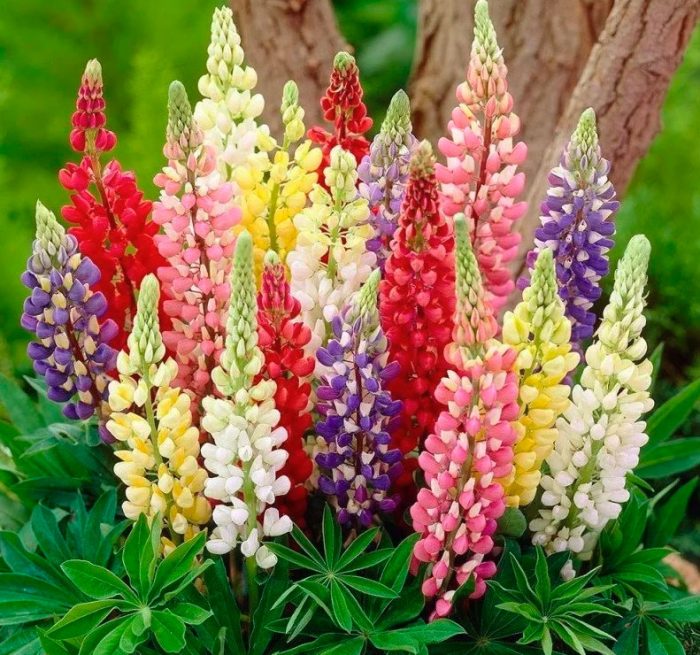
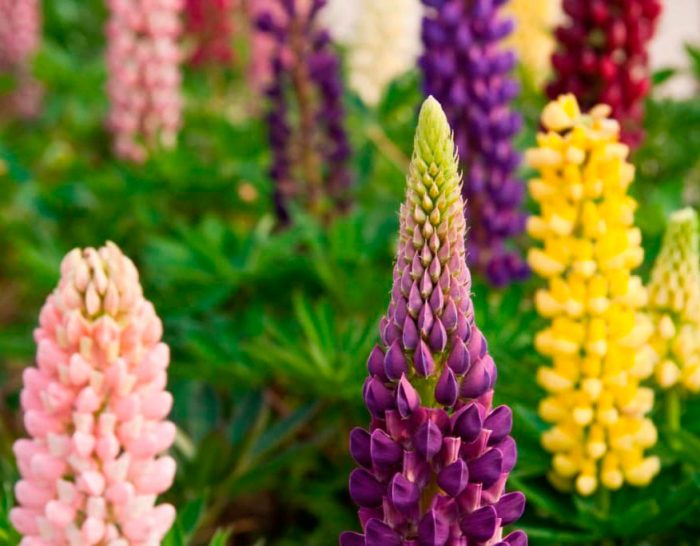
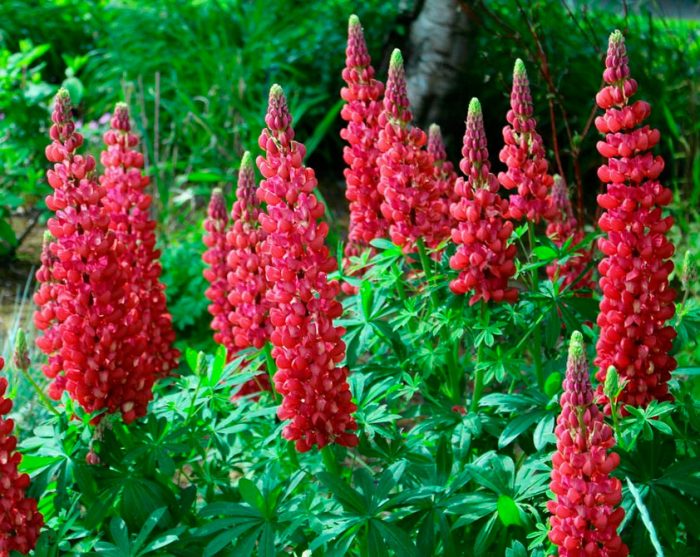
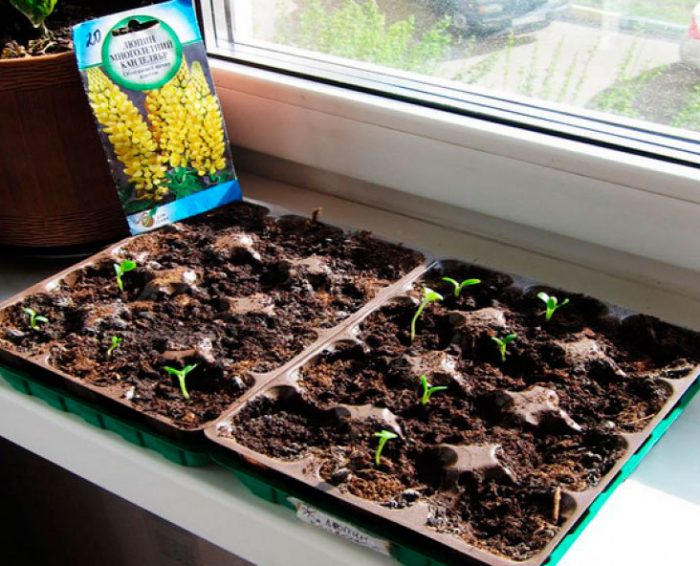
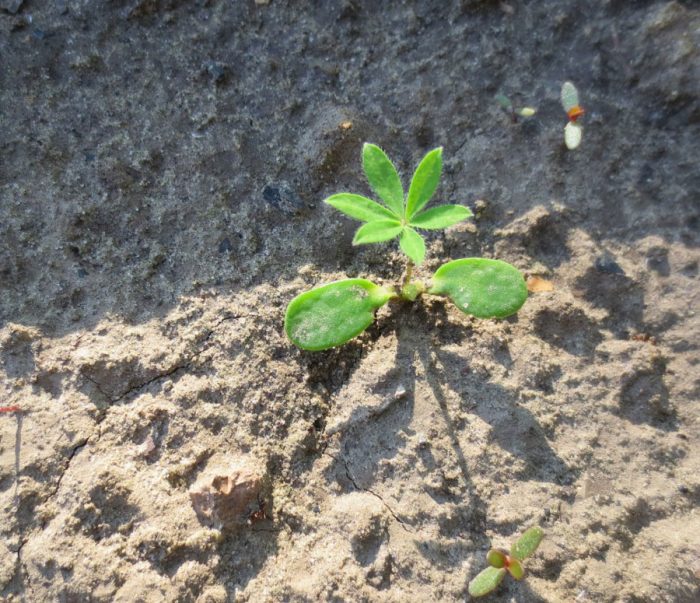

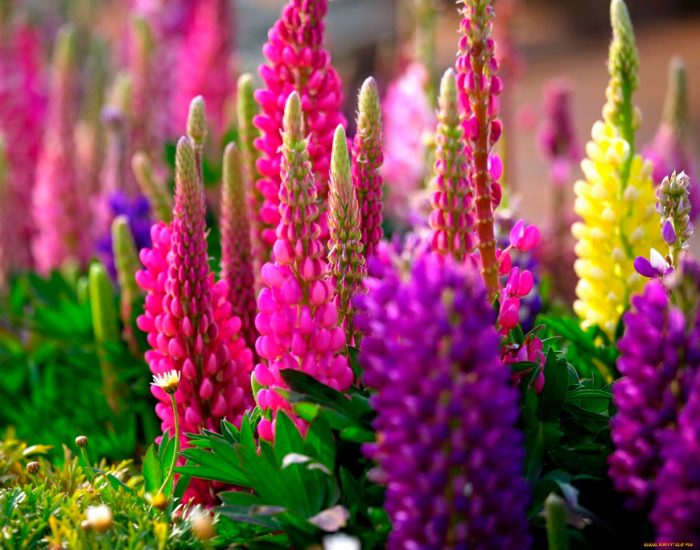
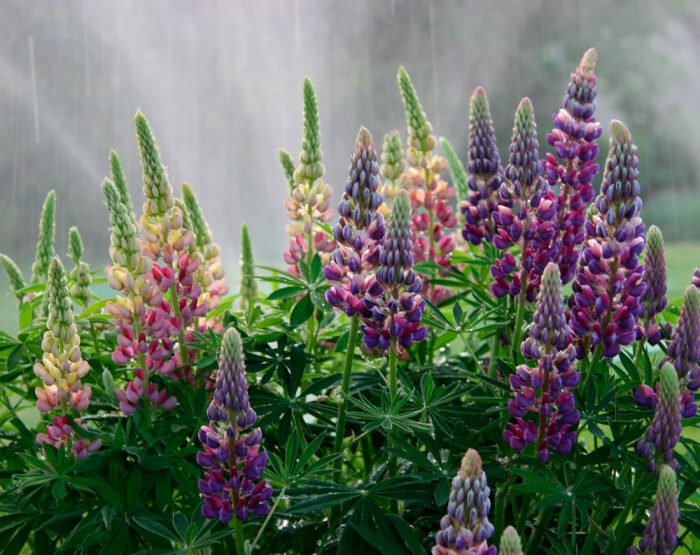
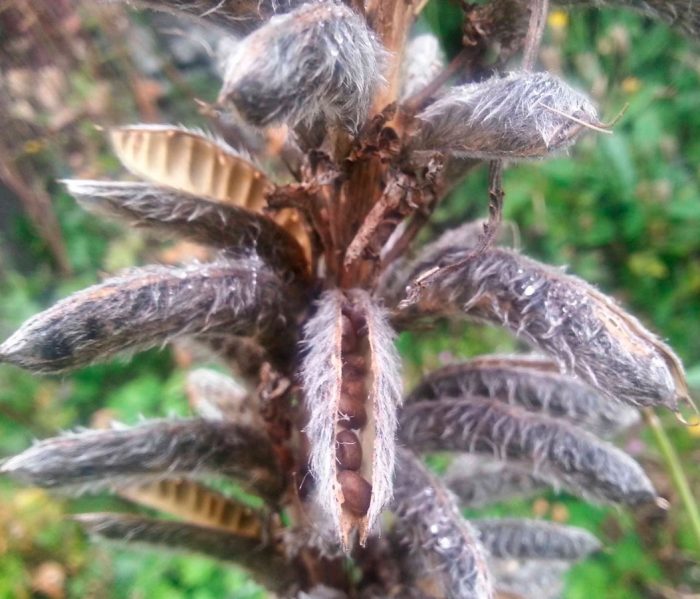

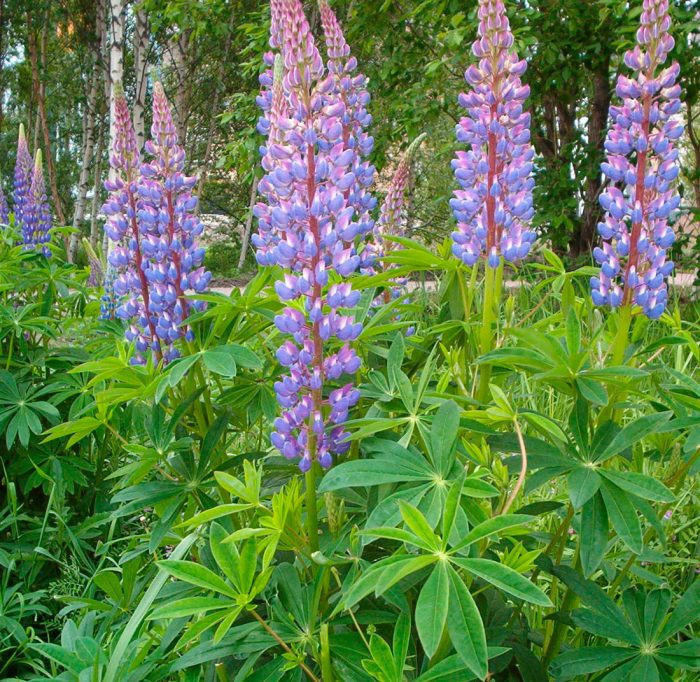
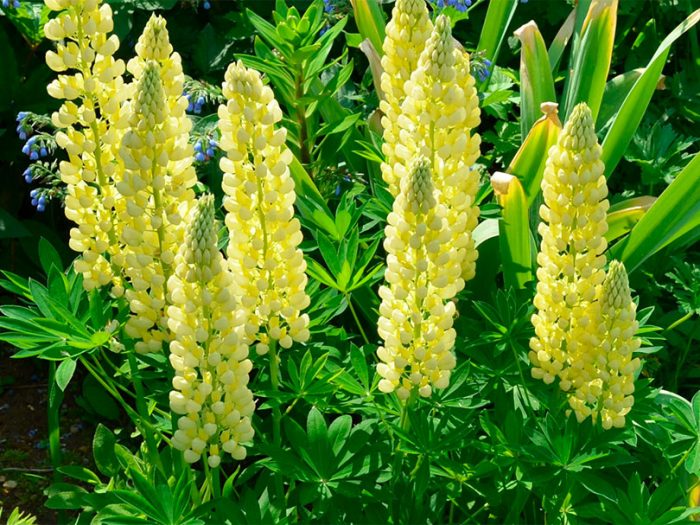
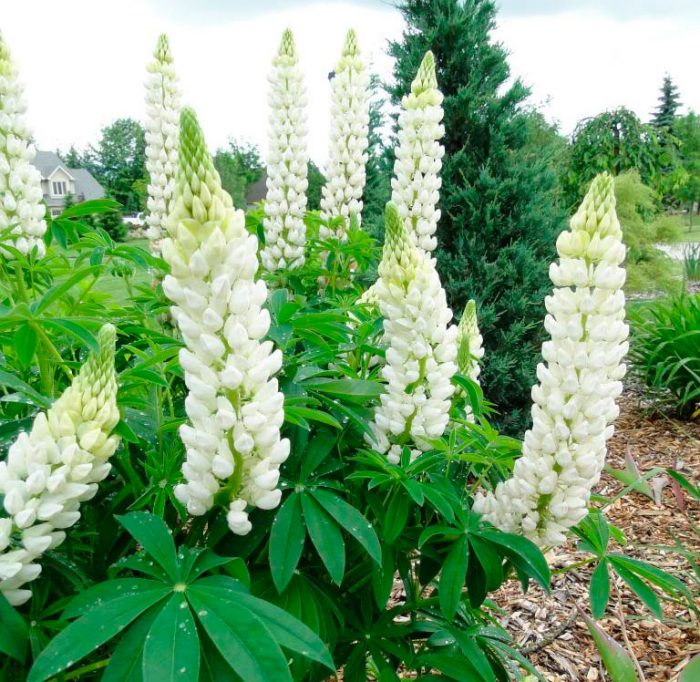
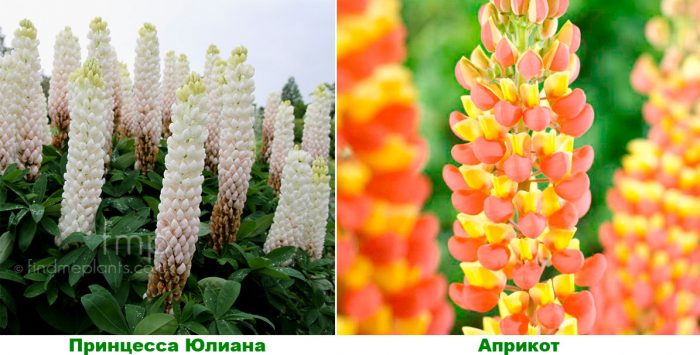







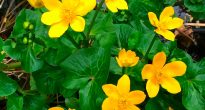


The main thing is not clear. What is the use, besides decorativeness, is lupine? I grew up for a couple of years, did not know what to do, and pulled out.
He is a good siderat. Used as mulch for high beds. The main thing is to make sure there are no seeds left. Otherwise, it will come out everywhere.
Raspberry breeders use lupine for feeding in the form of mulch.